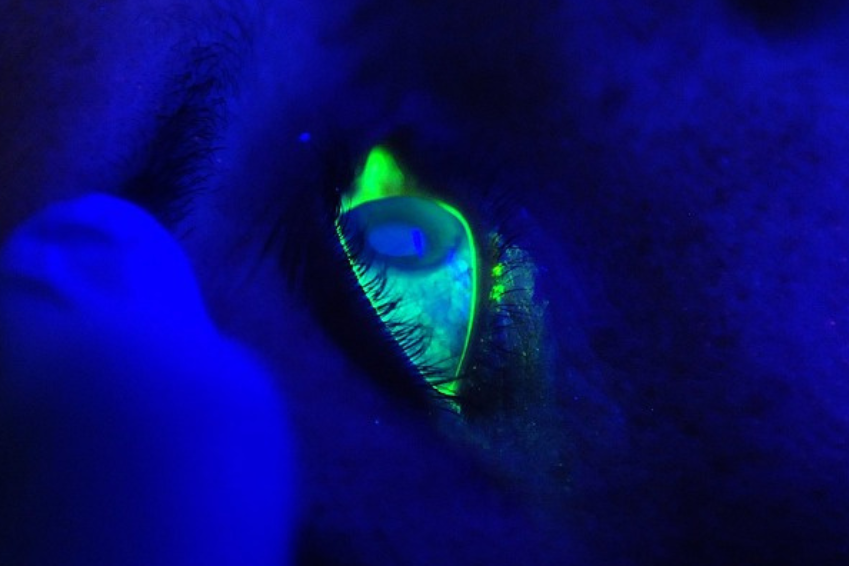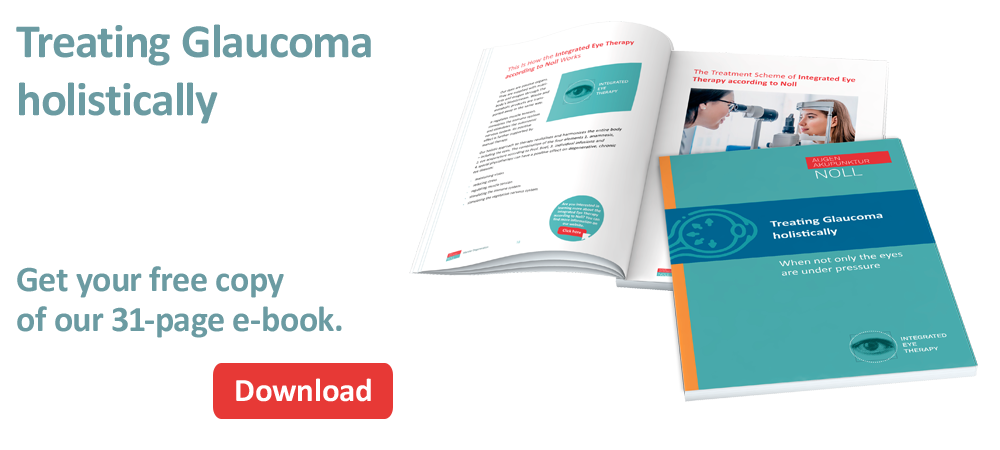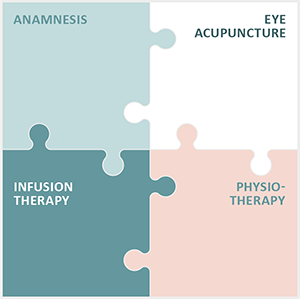Glaucoma laser surgery – selective laser trabeculoplasty (SLT)

Glaucoma laser surgery – selective laser trabeculoplasty (SLT) as a treatment method for glaucoma
Brief description of selective laser trabeculoplasty (SLT)
The gentle SLT laser trabeculoplasty for the treatment of glaucoma enables a scar-free method in which the outflow channel in the chamber angle of the eye is widened by laser treatment.
This creates new drainage possibilities for the aqueous humour, while the tissue in the chamber angle, the trabecular meshwork, remains intact.
How selective laser trabeculoplasty (SLT) works
SLT laser treatment for glaucoma uses tiny laser pulses that target the pigment in the chamber angle and activate macrophages (scavenger cells). These cells promote a remodelling of the trabecular meshwork, whereby the outflow structures for the aqueous humour are normalised again over time.
This painless treatment is usually performed on an outpatient basis and takes no longer than 10 minutes. It can also be repeated if necessary, and no complications have been reported to date. Usually, SLT laser treatment can help to reduce the strain on the optic nerve, which may reduce or even stop the use of glaucoma eye drops after treatment.
Clinical studies have shown that intraocular pressure was reduced by around 25% in around 75% of patients over a longer period of time.
Suitability of selective laser trabeculoplasty (SLT) from the patient’s perspective
On the recommendation of a doctor, selective laser trabeculoplasty (SLT) is particularly recommended for patients with so-called open-angle glaucoma. In this form of glaucoma, the drainage system for the inner aqueous humour in the front of the eye remains open, allowing the aqueous humour to drain naturally.
SLT is also a sensible alternative for glaucoma patients for whom eye drops are not an option due to intolerance. Under certain circumstances, SLT can also be used as a complementary measure or to end existing drug treatment, provided that laser treatment achieves a sufficiently low intraocular pressure.
Benefits of SLT treatment for patients
SLT treatment can be beneficial for patients with glaucoma in various cases:
- Open-angle glaucoma and relatives: SLT is suitable for patients with open-angle glaucoma, pseudoexfoliation glaucoma or pigmentary glaucoma.
- Problems with glaucoma drops: If patients have difficulty tolerating glaucoma drops or dripping their eyes, SLT can be an alternative.
- Combination therapy: SLT can also be used in addition to existing glaucoma drops.
- Difficult treatment and check-ups: For patients who find it difficult to attend regular check-ups and treatments, SLT offers an option to improve glaucoma management.
- After an increase in eye pressure: If the eye pressure rises again after a previous argon laser trabeculoplasty (ALT), SLT can be a solution.
Advantages of the glaucoma laser surgery selective laser trabeculoplasty (SLT)
Selective laser trabeculoplasty (SLT) offers several advantages. The various advantages for patients with glaucoma at a glance:
- No systemic side effects: To date, there are no known systemic side effects of SLT.
- Better compliance and cost-effectiveness: The use of SLT does not lead to problems with treatment compliance or the costs often associated with glaucoma medication.
- Promotion of self-healing: SLT stimulates the body’s own self-healing process to improve the outflow of aqueous humour. This reduces the intraocular pressure without causing damage to the eye.
- Reimbursement by health insurance companies: Many health insurance companies reimburse the costs of SLT treatments.
Possible side effects of selective laser trabeculoplasty (SLT)
SLT treatment is generally well tolerated and associated with few side effects. Nevertheless, there are some rare but possible side effects:
- Inflammation: Inflammation may occur in the treated area. However, this is a rare reaction to SLT.
- Temporary increase in intraocular pressure: In some cases, there may be a temporary increase in intraocular pressure after SLT treatment. This effect usually normalises itself.
- Eye pain: Occasionally, patients may experience slight eye pain after SLT treatment. However, this is usually temporary.
- Conjunctivitis (inflammation of the conjunctiva): Another possible side effect is the development of conjunctivitis or conjunctivitis. This can occur after treatment, but is rare.
It is important to note that these side effects are rare and usually short-lived. Patients should inform their treating ophthalmologist of any symptoms they experience so that appropriate action can be taken.
Glaucoma laser surgery alternatives to selective laser trabeculoplasty (SLT)
In most cases, glaucoma is treated with medication in the form of eye drops. Argon laser trabeculoplasty (ALT) can be considered as an alternative laser treatment to SLT.
This method also achieves positive results, but has a higher rate of side effects, including inflammation and scarring due to the thermal tissue damage caused by the laser. Unlike SLT, ALT is not repeatable. For these reasons, ALT is used less frequently nowadays.
YAG laser iridotomy
The YAG laser is generally used preventively in patients with narrowing of the chamber angle and a shallow anterior chamber. The targeted application of the laser beam creates a small opening in the peripheral iris, which improves the circulation and drainage of the aqueous humour.
Acute angle-closure glaucoma is an urgent situation characterised by sudden, painful increases in intraocular pressure. Patients often suffer from severe headaches and notice a drastic deterioration in their vision.
Nausea and vomiting are other possible symptoms. In such cases, it is of the utmost importance to lower the intraocular pressure as quickly as possible, usually through the use of medication in tablet form or administered intravenously. Pressure-reducing and pupil-constricting eye drops are used.
The active ingredient pilocarpine causes the pupil to contract and thus widens the angle of the chamber. This improves the outflow of aqueous humour and lowers the intraocular pressure. To ensure the long-term improvement of aqueous humour circulation, there is the option of creating a small opening in the iris using a YAG laser, which is known as an iridotomy. This procedure prevents future glaucoma attacks.
Cyclophotocoagulation (CPC)
The ciliary body, part of the uvea, produces aqueous humour in the eye and regulates intraocular pressure. Cyclophotocoagulation (CPC) uses lasers or heat to reduce aqueous humour production. A laser beam is passed through the conjunctiva and sclera.
A distinction can be made between these types of cyclophotocoagulation:
- Trans-scleral cyclophotocoagulation (TCP): laser energy is directed onto the beam body from the outside, coagulating the tissue and reducing intraocular pressure. Used for advanced glaucoma.
- Endoscopic cyclophotocoagulation (ECP): An endoscope visualises the body of the beam, while an endoscope laser emits targeted laser energy. Precise treatment, can be combined with other operations.
- Diode laser cyclophotocoagulation: Another procedure in which laser heat coagulates the ciliary body tissue, reduces intraocular pressure and is performed on an outpatient basis.
Areas of application and advantages
CPC is mainly used for advanced glaucoma when other measures are not sufficient. It lowers intraocular pressure, is minimally invasive, enables long-lasting pressure reduction and customisation.
Risks and complications
Potential risks include eye infections, temporary irritation and intraocular pressure imbalance, which require careful monitoring.
Summary and outlook
Cyclophotocoagulation is effective in advanced glaucoma and requires careful consideration of the benefits and risks. The future of CPC lies in the further development of techniques and instruments for precise and individualised treatment. Research and clinical trials are needed to evaluate long-term effects and develop new approaches.
Trans-scleral micropulse laser therapy
Micropulse laser treatment is a less invasive glaucoma laser surgery alternative to conventional cyclophotocoagulation. The outflow pathway in the dermis is improved by an 80-second treatment.
This method is characterised by the short duration of the procedure and fewer follow-up visits. However, the pressure-reducing effect is difficult to predict, which may require repeated treatments and continued use of eye drops.
Transscleral MicroPulse Laser Therapy is primarily suitable for patients with open-angle glaucoma.
Treatment principle
Micropulse transscleral laser therapy (MP-TLT) aims to reduce intraocular pressure. This is achieved by destroying the ciliary body villi, which reduces the production of aqueous humour and improves the outflow of aqueous humour through the uveoscleral and trabecular pathways.
Procedure of the treatment
MP-TLT is an outpatient procedure performed either under local anaesthesia or occasionally under general anaesthesia. The average duration of the procedure is around 10 minutes. Under local anaesthesia, the patient remains responsive and the eye is protected by an eye bandage, which is worn until the day after the operation.
Aftercare procedure
The bandage is removed the day after the treatment and the operated eye is checked. The pressure-reducing eye drops continue to be used on the treated eye.
There may be a temporary decrease in visual acuity and vision, and full recovery of visual acuity may take up to 3 months. After the operation, the eye may be inflamed, more sensitive to light and more sensitive to external environmental influences. It is not normally necessary to wear a protective cap during the night.
As a rule, there are only short-term restrictions on activities such as driving, reading, bending and heavy lifting. You will receive further information on this during the consultation about the operation.
After the treatment, check-ups are obligatory one day, one week and one month after the operation, either with us or with your personal ophthalmologist.
Integrated Eye Therapy according to Noll – a supplement to modern glaucoma treatment
In the world of advanced medical procedures such as selective laser trabeculoplasty (SLT) for Glaucoma, the Noll Eye Acupuncture Practice offers a unique therapeutic approach.
Developed by Michaela Noll, the Integrated Eye Therapy according to Noll combines traditional and modern medical techniques specifically for the treatment of chronic and degenerative eye diseases. This holistic therapy includes:
- Comprehensive anamnesis: Detailed initial examination to determine the patient’s exact medical history and current complaints.
- Eye acupuncture according to Prof. Boel: Special form of acupuncture for the treatment of eye diseases with the aim of improving vision and alleviating eye complaints.
- Customised infusions: Customised infusion therapies tailored to the patient’s specific needs to promote overall health and well-being.
- Specific physiotherapy: Physiotherapy interventions specifically designed to support eye health.
The practice is particularly proud of the positive feedback from patients, which emphasises the effectiveness and success of Integrated Eye Therapy according to Noll.
This approach is a valuable addition to conventional medical therapies such as SLT, as it utilises both traditional and innovative treatment methods.


